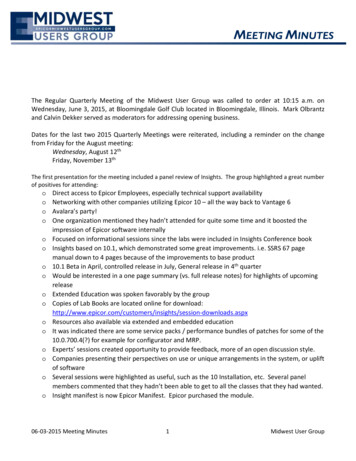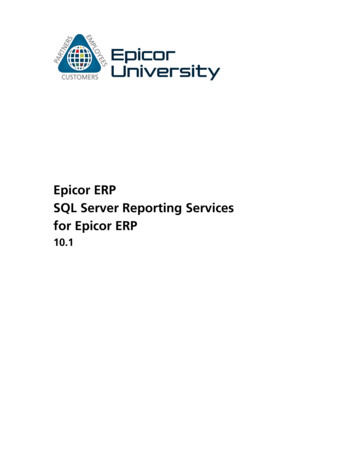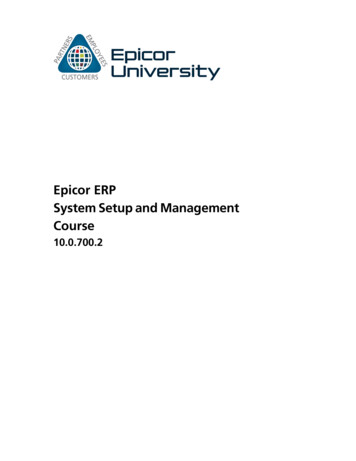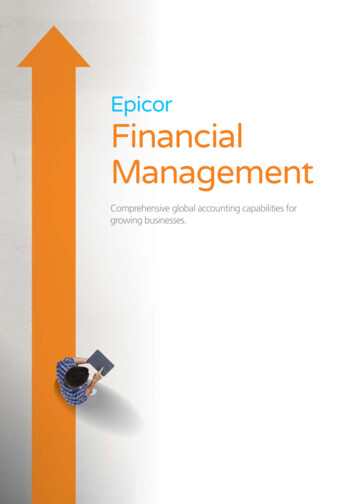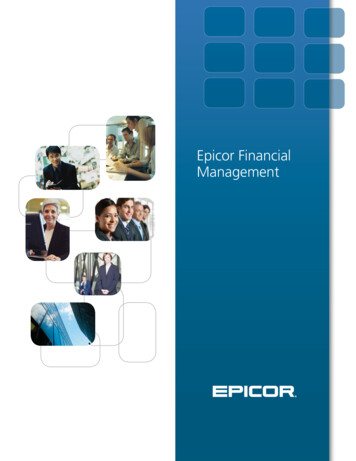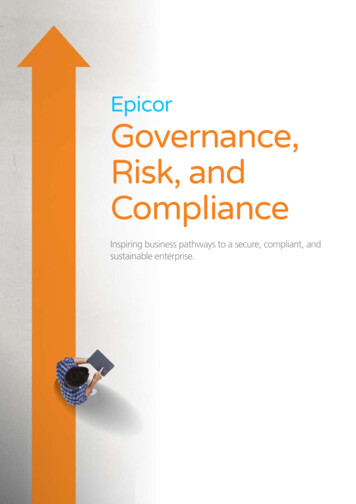
Transcription
EpicorPlanning and Scheduling
Planning at peak performance tomaximize business profitability.
EpicorPlanning and SchedulingPerformance-driven companies have mastered the art of predictingand responding quickly to changes in customer demand with minimalbusiness interruption. Whether you are a global, multisite enterprise or asingle site manufacturer or distributor, precise and flexible planning andscheduling is imperative to efficient and profitable operation. Epicor offersa comprehensive solution for forecasting, material requirements planning(MRP), scheduling, and advanced planning and scheduling to meet theneeds of today’s agile businesses. For companies with complex processesthat require project management and resource management capabilities,Epicor Planning and Scheduling offers a comprehensive solution that isbaked into the fiber of the product for unparalleled operational visibility.Financial ManagementSupply Chain ManagementCustomer RelationshipManagementProduction ManagementSales ManagementPlanning and SchedulingHuman CapitalManagementService ManagementProduct Data Management Forecasting and Master Production SchedulingForecast Pro for EpicorMaterial Requirements PlanningScheduling and Resource ManagementAdvanced Planning and SchedulingMultisite ManagementProject Management
Forecasting andMaster Production SchedulingFocus: A simulation technique where forecasts from the pastare simulated, using several simple or statistical algorithms, andthen compared to what really happened in the past. Six differentstrategies are available:Forecasting and Master Production Scheduling (MPS) in Epicorare designed to assist manufacturers and distributors with bothday-to-day control and long-range planning and decisionmaking. Forecasting and MPS support your business strategies,as well as those businesses that operate multiple, mixed-modestrategies simultaneously. Forecasts can be generated frommultiple historical sources (e.g., sales, invoice, and inventoryusage history). Past periods this year Moving averages Past periods last year Straight line Growth over last year Exponential smoothingStatistical: A method which uses mathematical algorithms to fitcurves to the historical time series. Three different strategies areavailable in the strategies dialog box when you choose statistical: Moving averages Exponential Straight lineForecast BucketsBucket forecasts in any way: daily, weekly, monthly, yearly, etc.Forecast AnalysisForecast any number of variables (e.g., revenue) rather than justforecasting product units. Forecasting allows any number of tiersto be forecast and analyzed (e.g., forecasting product units bycompany, state, city, and customer).Inter-Company TradingDynamically accept forecasts from other companies within theenterprise. This allows companies to give visibility to the supplycompany of future demand without needing to raise a firm intercompany order.Display a forecast by customer and part number with informationimported from a variety of sources.MPS EntryManually enter or cut-and-paste MPS from other applications.Manual Forecast EntryManually enter forecasts for companies, plants, customers, dates,and parts. Users can cut-and-paste from other applications intothe forecast system.Forecast to MPSForecast ExportMake and alter MPS decisions based on constraints. Bothforecasting and MPS can independently drive future demand.Automatically generate the MPS for forecasting.Driving Capacity and Raw Material ProcurementExport historical information to third-party applications for thecalculation of forecasts.Forecast Pro for EpicorForecast ImportImport forecasts from other applications or customers. Importoptions allow forecasts to be broken down by part, customer,plant, date, and company. This import can be additive, updatethe existing forecast, or a complete clear and re-load.Forecast Pro for Epicor is a comprehensive forecasting solutiondesigned for accurate automated forecasting, collaborativeforecasting, working with complex hierarchies, maintainingmultiple forecast overrides, documenting your forecastingsessions, and integrating with other systems. With Forecast Profor Epicor you can create accurate forecasts quickly and easilyusing proven statistical forecasting methods such as ExponentialSmoothing, Box-Jenkins, Event Models, Multiple-level Models,Seasonal Simplification, Low Volume Models, IntermittentDemand Models, Moving Averages, Curve Fitting, andSimple Methods.Forecast MethodsEpicor Enterprise Performance Management (EPM) offers anumber of forecasting methods:4
Save and Restore ForecastsForecast Pro for Epicor allows you to save and restore yourforecasting sessions including the forecasting models used, theforecast overrides and their associated comments, and all of yourreporting options.Manage HierarchiesWith the Forecast Pro for Epicor powerful “shuffling” capability,you can rearrange your hierarchy on-the-fly. Need to generate areport showing product level forecasts broken out by customerand then create another report showing customer-level forecastsbroken out by product? No problem!Exception ReportingFocus on the items that need attention with Forecast Pro forEpicor comprehensive exception reporting, you can automaticallyflag exceptions, saving you from manually reviewing everyforecast. Exception reports allow you to analyze the forecastsyou are currently working on as well as previously completed andarchived forecasts.Use Forecast Pro for Epicor Expert Selection capabilities to simplify theforecast process by creating accurate forecasts automatically.Expert SelectionForecast Pro for Epicor Expert Selection mode analyzes each itemand selects the appropriate forecasting method automatically. Ifyou prefer to specify the forecasting approach, Forecast Pro forEpicor provides a complete range of forecasting methods and allthe diagnostic tools you need.Monitor Forecasting PerformanceForecast Pro for Epicor maintains an archive of your previousforecasts (including the statistical forecast as well as the adjustedforecast) so you can compare forecasts vs. actuals. With just aquick glance at Forecast Pro for Epicor waterfall reports you canzero in on what’s working and what isn’t.Proven Statistical Forecasting MethodsForecast Pro for Epicor supports Exponential Smoothing,Box-Jenkins, Event Models, Multiple-level Models, SeasonalSimplification, Low Volume Models, Intermittent DemandModels, Moving Averages, Curve Fitting, and Simple Methodssuch as same-as-last-year and same-as-last-year plus growth.Consolidate Team ForecastsForecast Pro for Epicor allows you to break large forecastingprojects into smaller pieces that can be worked on separatelyand then reassembled into consolidated forecasts. For example,if three demand planners are responsible for three differentgeographical areas they can work independently and oncethey’ve completed their work, the forecast can be consolidatedfor further review and manipulation.Adjust the Forecast with Business ExpertiseForecast Pro for Epicor lets you adjust your forecasts on a graphor in a spreadsheet-like display—in either view, you see boththe historical data and forecasted values, allowing you to easilycompare patterns within the data. Adjustments can be made atany level in your hierarchy and automatically reconciled. A handycommenting facility allows you to document any adjustments.Forecast Pro for Epicor CollaboratorForecast Pro for Epicor Collaborator is a fully integratedcompanion product to Forecast Pro for Epicor which provides aneasy and affordable way to collaborate with colleagues. ForecastPro for Epicor Collaborator allows others to view your forecasts—including graphs and reports—add overrides and comments, andsave the results.Make Convincing PresentationsWith Forecast Pro for Epicor, you can create dazzling,presentation-quality reports in seconds. Four professionallydesigned standardized report formats are included as well as acustom reporting option for maximum flexibility. Forecast Pro forEpicor writes directly to Excel (.xls and .xslx), making it easy toshare your work.Work With Your Existing Epicor DataForecast Pro for Epicor imports data in a variety of flexible, easyto-create formats including Excel, text files, and ODBC. Theseflexible formats allow you to easily import and export data fromyour Epicor system or other external systems.Collaborate with OthersWorking with colleagues can also improve the forecastingprocess. Using up to ten customizable override rows and handycomment fields, you can easily collaborate with your colleaguesand document your changes to foster a truly collaborativeforecasting process.5
Material Requirements PlanningBuilt for the needs of the single site as well as extendedenterprise, MRP offers cross plant and cross company planning.Enhanced to offer plant source as well as product groupsourcing of materials and assemblies, MRP automatically andvisually extends the enterprise to efficiently manage supplyand demand.ForecastEnter general part forecasts or specific customer/part forecasts.MRP consumes the forecast with actual orders as they arereceived. View lower-level component requirements with longlead-times before the end part is released.Manual ForecastManually enter forecasts for companies, plants, customers,dates, and parts as well as cut-and-paste from other applicationsinto the forecast system.Check supply and demand of a part with Available-to-Promisefunctionality.Forecast ExportPart Planning ToolsHistorical information can be exported out to third-partyapplications for the calculation of forecast.Account for production prep, kit, and receipt time. Use thisto derive appropriate lead-time for producing the product inaddition to cycle-times required to produce the product.Forecast ImportPlan as AssemblyImport forecasts from other applications or customers. Importoptions allow forecasts to be broken down by part, customer,plant, date, and company. This import can be additive, updatethe existing forecast, or a complete clear and re-load.Use Plan as Assembly to plan lower component manufacturingparts without the need to include them in the full assemblystructure. This feature enables complex planning for Multilevelcomplex parts with components that are typically stocked.Master Production ScheduleEnter production forecasts for specific end parts using the MPSfunction. Perform an iterative process of entering a plannedschedule, viewing the effect on your resources, then modifyingthe plan until you have achieved an optimal schedule.Planning HorizonMRP GenerationUse predefined rules to firm and move MRP productionrequirements to production planning automatically, for rapidresponse to current demand.Review the planning horizon of a part or resource, then plan to,but not beyond the horizon, preventing premature planning.Auto Job Firm ProcessRun MRP with either net change or full MRP regeneration options.The MRP generation process balances the demand of customerorders and forecasts with the supply of jobs. As orders andforecasts change, MRP automatically adjusts corresponding jobs soyou are in balance. MRP even reschedules your plant for you.MultisiteSee what changes were made by MRP in the log file.Run MRP for all plants or for individual plants withina company. Changed schedule dates roll down to allsubcomponents—even those being manufactured inanother plant.Material PlanningMultilevel PeggingLog FileCreate purchase order suggestions for inventory and purchasedparts that are needed to complete production. Use lead timesand vendor price breaks to determine when the part should beordered and at what price.Analyze all the supply and demand in your system, then pegeach supply against demand, prioritized by due date. Becausesupply is calculated for every inventory item from all possiblesources—regardless of whether demand exists—you are alertedto items that may be overstocked or obsolete.Dynamic Lead-TimesSourcing By PlantTake into consideration variables such as the batch size,production calendar for a resource, the run rate of the resourceutilized and the availability of material flagged as constrained inproduction schedules.Define a unique source per part or plant—whether its defaultsourcing is purchased, produced, or transferred. What isproduced in one location may be purchased—or transferred in—from another.6
Scheduling and Resource ManagementAvailable-to-PromiseView running balances with the available-to-promise function.Enter a quantity, and the system will find the earliest date thatquantity will be available. Enter a date, and see how many partsare available on that day. MPS, forecast, order, and plannedreceipt quantities are visible to help you in your productionplanning tasks.Multiple resource views and online scheduling tools such asthe change impact informer offer the master scheduler andmanager the ability to visually locate overload problems andslack conditions, then perform cost and throughput analysis onschedule changes before they are firmly committed.The scheduling engines uses several factors that affectproduction quantity, setup time, production time, capacity,priority, and so on to calculate how long it will take each jobto complete. It then displays the schedule through the JobScheduling Board, the Resource Scheduling Board, and theMulti-Resource Scheduling Board.Planning TypesMaximize your planning accuracy with multiple types ofinventory planning, including minimum/maximum/multiple, daysof supply and run out.Rough Cut HorizonEnable MRP to process more efficiently by removing thetime spent scheduling beyond a specified threshold or roughcut horizon.Recycle JobsMRP reuses un-firm jobs for optimum MRP performance.Short Horizon Days of SupplyTo optimize MRP performance, a Short Horizon Days of Supplyfield is included within the Part Maintenance program on thePlant Detail sheet. This field defines a material value that willbe used when MRP determines that the needed materials fallswithin the Short Horizon. Here’s how this is calculated: If that day is Schedule Start Date Short Horizon Days,then the Short Horizon Days of Supply value will be used forthe materials.Manipulate the schedule directly from a sophisticated, drag-and-dropvisual scheduling board. If the date is Schedule Start Date Short Horizon Days thenthe Standard Days of Supply value will be used.Production Scheduling BoardEasily manipulate the schedule with drag-and-drop and drilldown techniques for Multilevel assemblies and operation details.A main control center for scheduling resources graphicallydisplays schedule by job, resource, resource group, or entireplant. Dynamically change the timeline of the view to seeshort-run operations and analyze the impact of long runningoperations instantly.Short Horizon PlanningThe Part Maintenance program includes the Short HorizonPlanning functionality. The Part-Plant sheet contains thefollowing fields: Horizon Days, Min Lot Size, and Max Lot Size.Calculate Manufacturing Lead TimePlan for part components lower down in the assembly structurefor accurate MRP scheduling.AlertsView indicators, such as late status and material availability, toproactively alert the master scheduler to potential problemsin the schedule. Optionally customize colors to denote actual,what-if, or delinquent load by job or operation.Start Minimum QuantityAccount for partial material availability in MRP calculationsto get started earlier with available material and improve deliveryperformance.Finite SchedulingSchedule and reschedule with flexible, finite real-time schedulecapabilities for a single job and plant-wide global finite capacity.Features include job locking for key operations or jobs, userdefined priority, and capacity load leveling by resource andresource group.Bill of MaterialsMRP checks the revision level and verifies approvals beforepulling in a standard BOM and routing. For parts that do nothave a current approved revision, a job suggestion is created inthe new/change order queue to help ensure requirements arenot lost.7
Start TimeChange ImpactYou can define a Start Time for this scheduling process. Thisfeature lets you run Global Scheduling during the current date,as you can indicate from what specific point in time the globalfinite scheduling process will begin. Previously this function onlyallowed you to begin Global Scheduling on the next day.View the potential changes for cost and throughput to theschedule after creating what-if scenarios.Dual Resource ConstraintsUse a secondary resource constraint (e.g., a tool or employee) infinite capacity scheduling in addition to the primary resource.Drag-and-DropConditional Forward ScheduleDrag-and-drop scheduled load hours forward or backward toalleviate the overload and effectively reschedule when faced withoverload conditions at critical resources or resource groups.Optionally allow the system to perform a forward schedule basedon a start date of today when performing a backward schedule ifa current date is encountered.Operation Complete Quantity DisplayedResource GroupThe Job Scheduling Board, Resource Scheduling Board, andMulti-Resource Scheduling Board all have an OperationComplete Quantity field on their Detail sheets. This fielddisplays the number of parts that are so far complete on thecurrent operation.Define an unlimited number of resources within a resourcegroup. Resource groups can be used in the planning processwith the actual resource assigned automatically based onavailability of individual resources. Resources may have uniquecalendars, and values for hourly/daily capacity,queue-andmove-time.Operation Complete Time DisplayedBoth the Job Scheduling Board and Resource Scheduling Boarddisplay the Operation Complete Time value after you move anoperation. This shows you the amount of time that is left tocomplete the operation.Finite Load HorizonPrevent the schedule from making adjustments too far into thefuture—potentially impacting material purchases and resourceallocations—with finite load horizons (e.g., time fences or cutoffdates) for finitely scheduling load on the resource.Overload InformerDisplay each date and resource/resource group, where scheduledhours exceed capacity based on what-if or actual job schedules.Access resource, resource-group, and job scheduling informationto review the causes of an overload and make schedule changesas needed.Resource-Based ScheduleDevelop a schedule for each individual resource deployed inthe schedule.Reschedule DeltaOptionally automate the system’s response to parts that areplanned to be early or late by a threshold number of days.Multilevel AssembliesManage complex assemblies by matching the schedule toactual production output. From branch- and componentlevel rescheduling to final assembly, Epicor ensures that allcomponents are on time and that nothing slips through thecracks. Visually explode high-level components to view lowerlevel component schedules.Rough Cut SchedulingKeep an eye on the future with Rough Cut Scheduling. RoughCut Scheduling is deployed to offer visibility of future productionwithout taxing system resources.Scheduling Factor Send AheadWhat-IfStart-to-start scheduled operations or operations scheduledto begin at the same time can be staggered based on an offsetfactor that is calculated by number of pieces or a percentage oftime allocated.Schedule jobs in a what-if mode, with the ability to analyzepotential bottlenecks before finalizing the actual schedule.Setup GroupingUse setup groups to streamline your setup processes.Dynamically assign grouping based on the criteria you define.Scheduling BlocksAccount for periodic processes with scheduling blocks.Scheduling blocks offer definition of periodic setup needs such astool changes or other processes.Capabilities with Zero PriorityWhen you schedule by capability, the Scheduling Engine selectsresources by the Priority value defined for each capability. Youcan assign a zero value to a capability’s priority. Any resourcethat is defined by this zero priority will not be selected by theScheduling Engine. It will, however, be available to use as aresource on the Start Activity or Labor Entry windows.8
Global Scheduling Component ProcessCapable-to-PromiseThe Global Scheduling process is divided into three components.You must run these components in the following order toglobally schedule your jobs:Easily manage customer expectation with real-time capableto-promise functionality in Order Management. Enabled withAPS, Epicor capable-to-promise uses the scheduling engine todetermine accurate promise dates and offers order processingsingle-click confirmation or order cancellation based on theprojected due date. Calculate Global Scheduling Order: This program is a setupprocess you must run before the Global Scheduling process.Each time this process is run, it will schedule any job that isa candidate for the Global Scheduling process. This processdetermines if each job will be early or late. This Early Days orLate Days value is then compared against the Priority codevalue on the job to determine a job priority sequence. TheGlobal Scheduling process will then schedule these jobs inusing this generated job priority sequence. Adjust Global Scheduling Order: This is an optionalcomponent you can run. Launch this program to reviewthe job priority sequence that was generated through theCalculate Global Scheduling Order process. You can use thisprogram to manually change the sequence through whichthese jobs will be scheduled during Global Scheduling. Global Scheduling: Run this process to schedule the jobs.All the jobs selected by the Calculate Global Scheduling.Order process will be placed within the schedule, either onthe actual schedule or on a What-If schedule. The jobs willbe scheduled in order using either the sequence generatedby the Calculate Global Scheduling Order process or themodified sequence you changed within the Adjust GlobalScheduling Order program.Consider production resources and create a visual finite schedule forimproved schedule accuracy.Multiple Resource Scheduling BoardEasily manipulate the schedule with drag-and-drop manipulationand drill-down techniques for multilevel assemblies andoperation details. A main control center for scheduling resourcesgraphically displays schedules for a group of resources in onescreen. Dynamically change the timeline of the view to seeminute operations and analyze the impact of long runningoperations instantly. Add memos to a schedule on theMulti-Resource Scheduling Board about any aspect of acurrent schedule.Material Constraints DisplayedBoth the Multi-Resource Scheduling Board and the JobScheduling Board indicate which materials are constrained. Onboth scheduling boards, the Related Materials grid now containsadditional columns that display this information. One columnindicates whether or not the material is constrained. The othercolumns define the purchase order, job, and lead time linked tothe constrained material.Multiple ConstraintsSet up every operation with multiple constraints orresources (e.g., machines, tools, skilled labor, rawmaterials, or available subassemblies).Advanced Planning and SchedulingAvailable as an extension to Scheduling, Epicor AdvancedPlanning and Scheduling incorporates the strength of theScheduling engine and enhances it with advanced functionalitysuch as multiple constraint scheduling, a wide range ofscheduling methods, visual drag-and-drop scheduling, capabilityand dependent capability-based scheduling, real-timecapable-to-promise functionality, and advanced materialplanning functionality.Resource EligibilityDefine resources within a specific resource group with individualcharacteristics to improve scheduling accuracy.Automated Scheduling by CapabilityDefine a capability or skill level that can be tied to multipleresources rather than a resource group or individual resource inthe planning process. The APS engine then determines, based onthe available resources, which individual resource to schedule forthe operation.Dependent CapabilitiesLink dependent capabilities that the scheduling engine schedulesalong with the primary capability when operations requiredependent skills to perform the operation.9
Multisite ManagementFinite or Infinite CapacityDefine each resource with either finite or infinite capacity.When a piece of the schedule is moved, the resource isrescheduled according to its type.Best-in-class enterprises are outpacing their competitors todaywith new initiatives to drive out redundancies and improve leadtimes. Maximizing the use of your internal supply chain can bea key differentiator. Not only are manufacturers and distributorslooking for new tools to oversee multiplant operations, theyare also looking to maximize the use of existing resources.Alternative production methods management helps optimizethe production processes for specific parts in each plant, basedon the resources available. Another optimization tool includesthe transfer of material or semi finished components to anotherplant for completion.Minimum WIP SchedulingUse a unique scheduling algorithm designed to minimize work inprocess by scheduling a job to ship as early as possible. APS thenback schedules to start working on the job as late as possible.Dimensional PlanningSchedule by volume and quantity using dimensional planningthat is not time constrained.Rate-Based SchedulingAbout EpicorSchedule cells based on production throughput rates ratherthan time.Epicor Software Corporation is a global leader delivering businesssoftware solutions to the manufacturing, distribution, retail,and service industries. With more than 40 years of experience,Epicor has more than 20,000 customers in over 150 countries.Epicor solutions enable companies to drive increased efficiencyand improve profitability. With a history of innovation, industryexpertise and passion for excellence, Epicor inspires customers tobuild lasting competitive advantage. Epicor provides the singlepoint of accountability that local, regional, and global businessesdemand. For more information, visit www.epicor.com.Material ConstraintsConsider material availability as a scheduling constraint.Integrated directly with Inventory and Purchasing, the APSsystem knows when material is due and schedules accordingly.Advanced Material PlanningIncrease throughput by considering material and componentavailability as a constraint. Advanced material planning, anintegral feature of APS, facilitates intelligent stocking andprocurement of material requirements.The schedule function recognizes materials earmarked asconstraints, gives the master scheduler material availability, andconsiders supplier calendars for a more realistic schedule.Change Impact AnalysisSee the immediate impact of proposed changes on other ordersto make informed decisions about desired changes.Time AdjustmentAutomatically take into account resource utilization and resourcegroup efficiency for more accurate load calculation.Optimization RulesGenerate a schedule based on rules assigned toindividual resources.Balanced OptimizationConcurrently consider priority, slack time, and setup time whendetermining load balance.Single Cell SchedulingSchedule an entire job or assembly within a single work cell.Unlimited What-IfCreate unlimited what-if scenarios to view the effect of changeson your shop floor.Multi-Plant CommunicationEnsure that interdependent plant schedules are coordinated.10
For more information or to talkto one of our ERP consultantsabout your requirements pleaseget in touch:solutions@epaccsys.com 44 (0) 116 248 7518www.epaccsys.comThe contents of this document are for informational purposes only and are subject to change without notice. Epicor Software Corporation makesno guarantee, representations or warranties with regard to the enclosed information and specifically disclaims, to the full extent of the law, anyapplicable implied warranties, such as fitness for a particular purpose, merchantability, satisfactory quality or reasonable skill and care. Thisdocument and its contents, including the viewpoints, dates and functional content expressed herein are believed to be accurate as of its date ofpublication, April 2014. The usage of any Epicor software shall be pursuant to the applicable end user license agreement and the performance ofany consulting services by Epicor personnel shall be pursuant to applicable standard services terms and conditions. Usage of the solution(s)described in this document with other Epicor software or third party products may require the purchase of licenses for such other products. Epicor,Business Inspired, and the Epicor logo are registered trademarks or trademarks of Epicor Software Corporation, registered in the United States andcertain other countries.Microsoft and Windows are either registered trademarks or trademarks of Microsoft Corporation in the United States and/or other countries.Apple, iPad, and iPod are either registered trademarks or trademarks of Apple Inc., registered in the United States and other countries. Google is atrademark of Google Inc. in the United States and/or other countries. Magento is either a registered trademark or a trademark of Magento (adivision of X.commerce, Inc.), registered in the United States and other countries. All other trademarks mentioned are the property of theirrespective owners. 2014 Epicor Software Corporation. All rights reserved.
Production Management Planning and Scheduling Forecasting and Master Production Scheduling . invoice, and inventory usage history). Display a forecast by customer and part number with information imported from a variety of sources. Manual Forecast Entry Manually enter forecasts for comp

